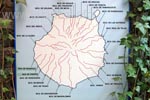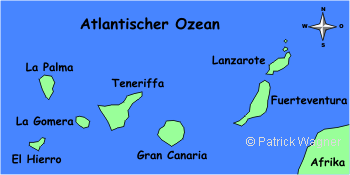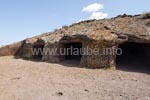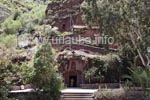|
|
|
General Information of Gran Canaria
Every year, millions of tourists are on holiday in Gran Canaria. as in Gran canaria it is possible to have bathing holidays throughout the year and the beaches are very big, specially in the main holiday regions around Maspalomas and Playa del Inglés, the masses are also very widely spread so that oneself has not necessarily lay on the beach towel-to-towel with the neighbour. If one now thinks on a typical bathing island the way it is assiciated for example in Fuerteventury, then in case of Gran Canaria one is completely wrong or at least partly wrong. Each of the Canarian Islands is unique and has a special island character. In Gran Canaria, one experiences an impressive mix. 

With Tenerife, one associates the Teide as also the Teide-National-Park. Lanzarote is the island of volcanos and volcano landscapes. Fuerteventura has some big bathing beaches and a huge dune landscape. La Palma is the green island with the huge crater in the middle. And Gran Canaria? Gran Canaria is the island of the canyons and a fascinating mountain world. In the middle of Gran Canaria there are mountains of almost 2000 metres; due to this reason, the mountain world in the island centre is also called Massif Central. From the Massif Central, 7 main canyons start to all directions and branch off into 25 single canyons; No canyon is similar to the other. Some are steep and narrow, some offer a wide panorama to the hillside at the front. It is also this world of canyons that made our holiday in Gran Canaria to remain in a spectacular way in our memories for a long time. Situation and Size, Regions and LandscapesDue to the name Gran Canaria one could suspect that this island is the biggest representant of the Canarian Islands but it isn't. The biggest Canarian island is Tenerife, followed by Ferteventura; With 1560 km², Gran Canaria is the third biggest. The almost circular island Gran Canaria is only at 200 km distance from the African mainland and is approximately located at the level of the middle Sahara. This is also the reason why with a coastal length of approximately 240 km the main part of the sand beaches that is of not more than 32 km, is oftenly located at the south and the east part of the island. Additionally, there are pebble beaches of about 25 km. The biggest part of the coast runs alongside some steep coasts and cliff lines of a total of 140 km. With 53 km, the widest diametre from north to south is not that big, but the centre of the island is something special with its Massif Central. If one wants to get comfortably and fast from the north to the south, the best is to take the motorway that leads in the east alongside the coast. 
In the centre of the island there is also the highest altitude at the same time: The Pico de las Nieves (Snow-Tip) with aheight of 1949 metres. From here, one has a breathtaking view over the clowds up to the 'Big Brother' of Tenerife: the Teide. In Gran Canaria, Pico de las Nieves is neighboured by several altitudes. In the right proximity, there is the Roque Nublo with 1817 metres and the Roque Bentayga that with an altitude of 1412 m cannot offer such a proud altitude but therefore a significant cultic history and a spectacular environment. All altitudes are a part of the bigger Massif central that, as I already mentioned, branches off to the coast in some spectaculat canyons. Here above in the northern mountain world of Gran Canaria, the environment is, all of a sudden, much more verdant and rich in plants. By this way, one does not learn about the difference faces of Gran Canaria until doing an island tour or having a drive to the Massif Central. From even, scant and desert, almost desert-like pictures of the east and south coast, in the centre, west and north there is not much of this. Thus, for example the whole western part is leafy naturally protected area that abruptly falls from high cliffs into the water; Also the north east with its mainly agriculturally used surfaces almost reminds one on the much greener island La Palma. The Origination of Gran CanariaDue to its volcanic action, the island Gran Canaria was originated approximately 16 million years ago. The original lava dome in the centre of the island broke down because there was so much lava coming out to the surface that only the edges of the dome were left. The Caldera de Tejeda of today is the result of the crater that broke down. The last volcanic actions are dated about 300 years ago. The lowlands at the coast only appear with the decline of the seas level. all of this areas were originated under the water. Also the dunes of Maspalomas known by all visitors are still originated by the interplay of wave and wind action. The corals finely ground under the water are flushed to the land by the waves and towered by the wind to high dunes. History and Population of Gran CanariaThe first population of Gran Canaria can be surely dated to the year 70 BC, even though there are assumptions that already 400 years earlier the ancient Canarians lived here. This originally stone-aged marked living environment can be explored in many museum and cave villages of Gran Canaria. Thus, for example, in the Mundo Aborigen, a big open air complex, the daily life and cult of the pre-historic people are scenically reenacted by lifelike figures. Such natural arenas as Cuatro Puertas where the caves and cult places are conserved until today, are also very impressive. Here, one must partly imagine what happened here at that time. 
Detail information about life and death, thus the cult of the dead of the ancient Canarians is for example available in the canyon of Guayadeque. In this musem that is an imitation of the original cave, one sees in a very impressive way by means of movies and video animations some different living areas of the prehistoric people. A side trip into this Centro de Interpretacion Guayadeque or also Museo de Sitio de Guayadeque in worthwhile ion any case as here, one gets a lot of information in different languages, a thing that we partly missed in the other museums. A further place full of history is the Roque Bentayga. Caves, cult places and the impressive form of the rock massif speak for themselves. Those who explore Roque Bentayga are in one of the most distinctive places that were inhabitated by the ancient inhabitants of Gran canaria. 
It is assumed that this pre-historic culture was not massively changed until the 15th century. Already in the 13th, some weuropean slave hunters came to the island. Several assaults in which a systenatical hunting of humans awas supposed to take place could be defenced by the locals. But during the time around 1480, with the foundation of Las Palmas by Juan Rejón, the systematical conquer of Gran Canaria started. The sugar cane became the first widely arranged monoculture of the island; therefore, numerous forests were cleared and the island clearly changed its appearance. But the high benefits from the export business of the sugar industry only last 50 year; the Brasilian competition was much too huge for Gran Canaria. The trade did not only go down due to this situation of competition in the year 1550, also the assaults by pirates with plunders and pillages seriously damaged Gran Canaria. 100 years later, people spcialised in the cultivation of wine, but due to the reason of the stronger competition of Tenerife and La Palma it only slowly developed. that could maintain its agricultural significance uo today. From then it took not much up to the year 1956 when the first charter land on Gran Canaria and the tourism began. Even though still today there is still agriculture in Gran Canaria, the main income of the island is, of course, the tourism. Flora und Fauna in Gran CanariaGeographically, Gran Canaria and Tenerife are in the centre of the Canarian Islands. This position in the centre is also noticeable in the flora. On the whole island there is not one single agricultural extreme that is dominating but a mix of conditions. For example, in the east of Gran Canaira with the almost desert-like conditions as in Fuerteventura and Lanzarote, or the verdant green and nearly sprawling fauna in the north-east of the island as in La Palma. The fauna of the Canarian Islands is less spectacular and therewith also not in Gran Canaria; Even on some long extended hiking tours one is lucky by coming across some wild rabits, rats, mouses or lizards. Sometimes, some sheeps or goats are visible in the higher mountains. There is no need to be afraid of bigger games or poinsoned small animals as snakes, spiders or scorpions. In the air or water it gets more variegated. Food and DrinksCertianly, the first thing that crosses one's mind in relation to food in an island is fresh fish or seafood and therewith one associates a light cuisine, but the spices, sauces and finally the way to cook in Gran Canaria rather tempts to be the one of a hearty simple fare. By this way, it is possible that one first has to get used to the classic food of Gran Canaria. What is in any case a must in the Canarian cuisine are Papas Arrugadas, small wrinkly potatoes tand eaten with the skin. Those who like potatoes will love it. Together with the actual emblem of the Canarian cuisine, the mojo-sauce, the papas arrugadas become a delicacy. There are three kinds of mojo-sauce: first, the basis of all mojo-sauces is s lot of garlic . Together with olive oil, vinegar and salt, the basis for a simple mojo is done. By adding some different herbs, the mojo verde results. Those who like it a little more hot can vary the mojo with red pepper in order to prepare a Mojo picón. Many times, in the restaurant, one previously gets some mojo served with bread. Also typical for Gran Canaria is gofio, a kind of compact mash that is either done of roasted cornmeal, barley or wheat. The preparation is very easy. By roasting the corn previously, there is no need to cook it anymore, so that the powdered wheat does not need to be coked or baken anymore. Stirred with water, warm or cold milk, one gets quickly a very satiable side dish. Also stews are part of the local cuisine, as also fish, of course paella, as also goatling or also rabbit in sauce. Back to the index Gran Canaria Copyright: Patrick Wagner, www.tourist-guide.biz |
||
